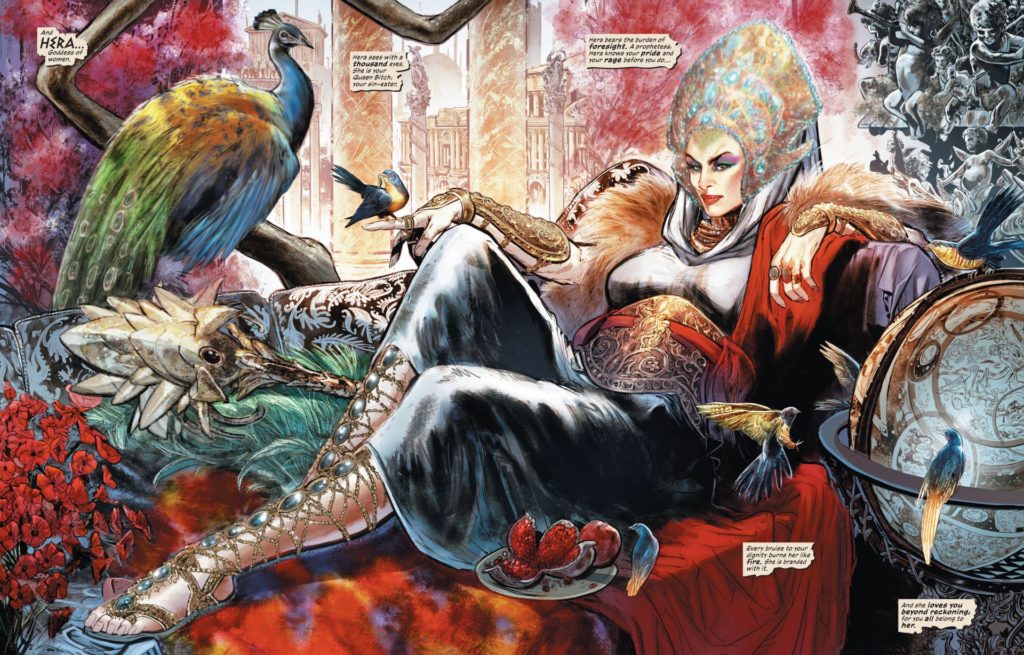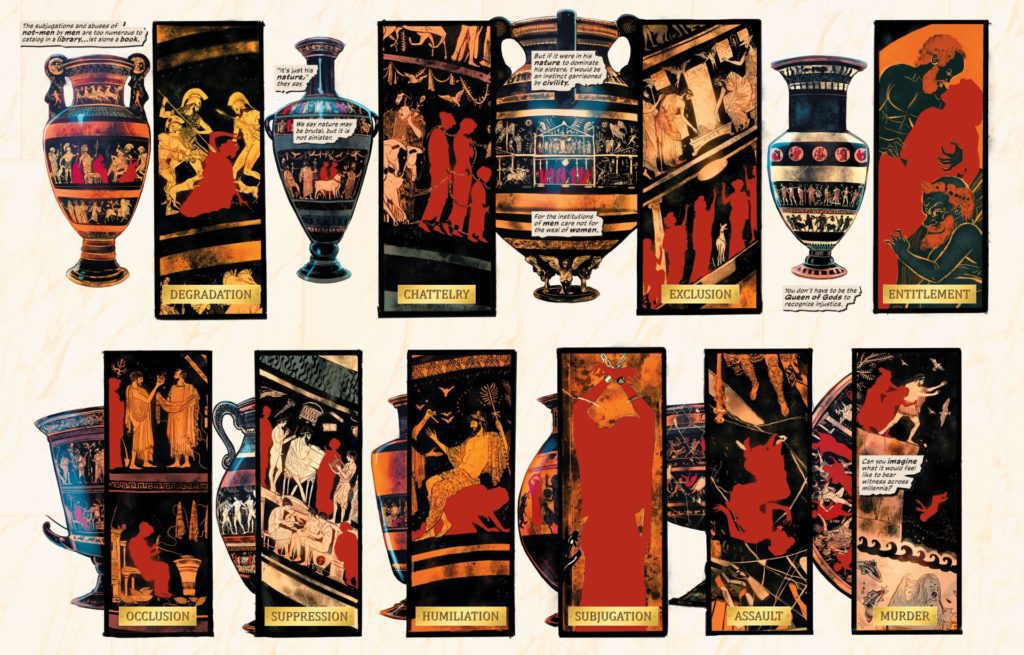Writer Kelly Sue DeConnick (Captain Marvel, Bitch Planet) and artist Phil Jimenez (Wonder Woman, The Invisibles) have come together to weave and uncover a new mythology in Wonder Woman Historia #1. With colors from Hi-Fi, Arif Prianto, and Romula Fajardo Jr. and letters from Clayton Cowles, this first chapter eschews the known history of the famous Amazon and digs deep into malleable nature of Greek mythology itself. As such, DeConnick and Jimenez have created something that surpasses the world of superhero storytelling and lands squarely in the realm of legend. With pointed, timeless writing and medium-breaking art, this comic could be the start of a new absolute essential read for the DC stable.
“The wait is over, and the entire story of the Amazons can finally be told! Millennia ago, Queen Hera and the goddesses of the Olympian pantheon grew greatly dissatisfied with their male counterparts…and far from their sight, they put a plan into action. A new society was born, one never before seen on Earth, capable of wondrous and terrible things…but their existence could not stay secret for long. When a despairing woman named Hippolyta crossed the Amazons’ path, a series of events was set in motion that would lead to an outright war in heaven—and the creation of the Earth’s greatest guardian!”
Writing & Plot
Kelly Sue DeConnick creates possibly the most effective script of her career in Wonder Woman Historia #1. Removed from the expectations of modern superheroes or current speculative fiction, the Bitch Planet writer settles on a brutal yet inspiring mythological tale in DC’s universe. Make no mistake, this comic can be both physically and emotionally jarring. Exploring the construction of the Amazons as a reaction to the treatment of women by a male-led society isn’t new by itself. Doing so with near-complete creative control, out of continuity, in a mature-readers book, is. DeConnick does not hide the reasons for Hera and the other goddess’s fury – nor the indifference of men. This topical treatment of mythological beings weaves in beautifully with elements of the known Wonder Woman story, while leaving mystery for the chapters to come.
Style
DeConnick adopts a narrative style that reads as a perfect mix of modern and timeless poetic writing. Her syntax and diction is reminiscent of Gaiman’s Sandman, but with her distinct voice making it markedly unique. DeConnick’s voices for each goddess is perfectly reflective of each being. Hera is measured yet stern, and speaks with the weight of knowing more than she lets on. Athena is matter-of-fact, with words of logic rather than just wisdom. Artemis is full of youthful anger and speaks mostly in quips and threats. Each of these characters are written so distinctly that we could pick out who was talking by just reading an out-of-context sentence.
I should perhaps warn that this is not a light comic. DeConnick’s portrayal of the pain women experience in the patriarchal world is unflinching and never steps away from its truth. In this fountain of emotional and poetic writing however, it will be easy for most readers to see the new/old mythology DeConnick is weaving for this series.
Art Direction
Holy crap, Phil Jimenez. When the first shots of art from Wonder Woman Historia #1 hit the internet, this quickly became one of the most anticipated comics of the past couple years. While DeConnick’s script is incredible, it’s Jimenez’s work that really makes this book a must-read. The modern icon steps outside of the style we’ve largely seen his use and into something almost monolithic. Much of the work here appears more like gallery work than something found in a comic book. Jimenez’s designs for the Greek gods and goddesses are both familiar and unique. The grace and power that Hera, Hestia, and Aphrodite are presented with is beautifully singular. The one that sticks out in my mind the most is Jimenez’s design for Hecate. The dark goddess is presented as multiple bodies all wrapped in barbed wire, and with different heads that take turns speaking.
Design
What’s so different about Jimenez’s renditions versus other artists for these goddesses is how ethereal they are. These beings feel like gods. The classic fallible nature in classic Greek mythology has led many artists to render them as appearing almost entirely human. Jimenez offers designs that, for some of them such as Hera and Demeter, are obviously human but still ethereal. However, with the likes of Athena’s bodiless form and Aphrodite’s starry, shimmering skin, the sense that these are cosmically powerful entities really sticks. It doesn’t hurt that the settings of Olympus and the Underworld also appear as nebulous voids of beauty and despair. Jimenez’s design language for the gods gives J.H. Williams III best work a run for its money.
Another smart feat of Jimenez’s here is how he morphs styles for scenes that take place on Earth. Here he switches to an approach that’s more like what we’ve seen from him in his other mainstream comics works. He adopts a more conventional panel style to tell a story from the perspective of the mortals who will late become very important to this history. I won’t spoil anything, but Jimenez’s art here is as stellar as always.
Color
A massive part of what makes the visuals so successful here is the coloring of Hi-Fi, Arif Prianto, and Romula Fajardo Jr. The barrage of tonal blends in the palette for the goddesses and their heavenly abode has that “reach your hand in” quality. The accented details for the characters themselves adds elements to their personality that are only outlined by Jimenez’s pencils. I get the sense that they were effectively allowed to run wild with their work here, and it pays off in spades. The letters from Clayton Cowles are varied and cleverly tonal, with just enough variance to convey scenes spectacularly well. Every visual aspect of this comic is absolutely stunning.
Verdict
Wonder Woman Historia: The Amazons #1 is a poignant and beautiful triumph of a comic. Kelly Sue DeConnick and Phil Jimenez craft what may be the best work of their careers in this mythic piece of storytelling. DeConnick’s topical and powerful script reads like a piece of timeless mythology that sets up later chapters while still feeling like a story in itself. Jimenez and the colorists craft a comic that transcends the rules of comic book direction to make something indescribably mesmerizing. This is an absolute triumph of a comic, so be sure to grab it when it hits shelves on 11/30!

